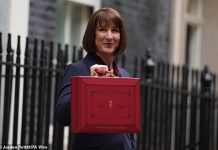Three in four savings accounts now offer a return of less than 4 per cent, new figures show.
Only one in four savings deals pays above the Bank of England base rate which now stands at 4 per cent, according to rates scrutineers Moneyfacts Compare.
The average savings rate, as recorded by Moneyfacts, fell to 3.46 per cent from 3.5 per cent monthly. The rate was last above 4 per cent in January 2024.
Meanwhile the average-easy access rate fell to 2.59 per cent, its lowest level since July 2023.
This is especially problematic for savers as due to rising inflation which has crept up to 3.8 per cent in the 12 months to August, almost double the Bank of England’s target of 2 per cent.

Three in four savings deals give savers a base rate return of 4 per cent
In August, the Bank of England said it expects CPI inflation to peak at 4 per cent in September.
Rachel Springall, finance expert at Moneyfacts Compare, says: ‘As inflation is expected to climb higher, this means the vast majority of savers will see their pots eroded in real terms.
‘This will be incredibly demoralising for savers who use their interest to supplement their income.’
The best easy-acccess deal currently pays 4.3 per cent. A saver keeping £5,000 in an account paying the average eay-acces deal, which offers just 2.59 per cent would earn £129.50 interest per year, whereas 4.3 per cent with Spring Savings would deliver £215 interest.
Some experts says savers should lock away their savings in a fixed-rate account while rates hold up.
Savings providers tend to offer better returns to savers who are prepared to lock their cash away for a set amount of time.
The best one year fix now pays 4.5 per cent and comes from Chetwood Bank. A saver stashing £5,000 in this account would earn around £230 in interest by the time the bond matures.
But the average one-year fixed-rate bond pays 3.96 per cent, down from 4.43 per cent this time last year.
Deposits into fixed-rate accounts more than trebled in the space of a month to £4.3billion during July, up from £1.2billion the month prior, Bank of England data show.
This was the highest monthly deposit since January 2025, of £5.8billion.
‘Savers who want to secure a guaranteed return on their cash may be wise to lock into a fixed bond or cash Isa,’ says Ms Springall.
SAVE MONEY, MAKE MONEY

Sipp cashback

Sipp cashback
£200 when you deposit or transfer £15,000
4.38% cash Isa
4.38% cash Isa
Trading 212: 0.53% fixed 12-month bonus

£20 off motoring

£20 off motoring
This is Money Motoring Club voucher

Up to £100 free share

Up to £100 free share
Get a free share worth £10 to £100

No fees on 30 funds

No fees on 30 funds
Potentially zero-fee investing in an Isa or Sipp
Affiliate links: If you take out a product This is Money may earn a commission. These deals are chosen by our editorial team, as we think they are worth highlighting. This does not affect our editorial independence. Terms and conditions apply on all offers.
#savings #accounts #pay #base #rate
















